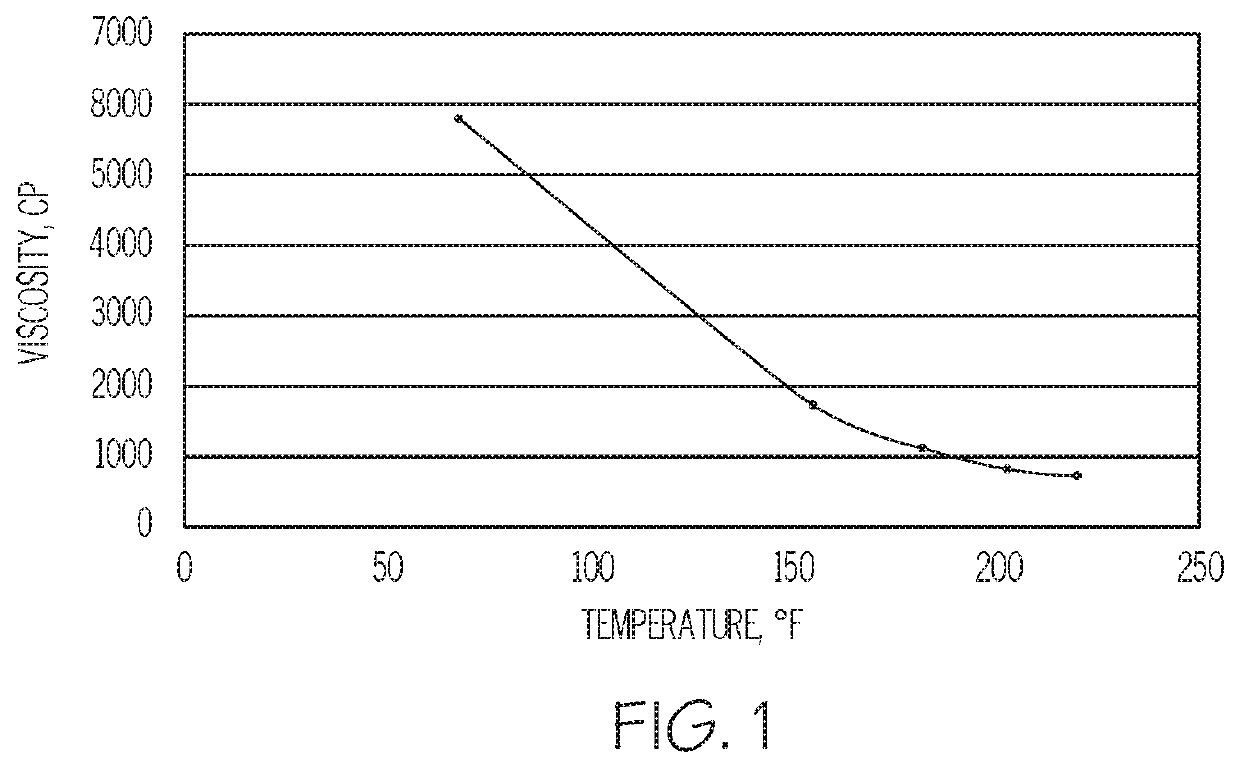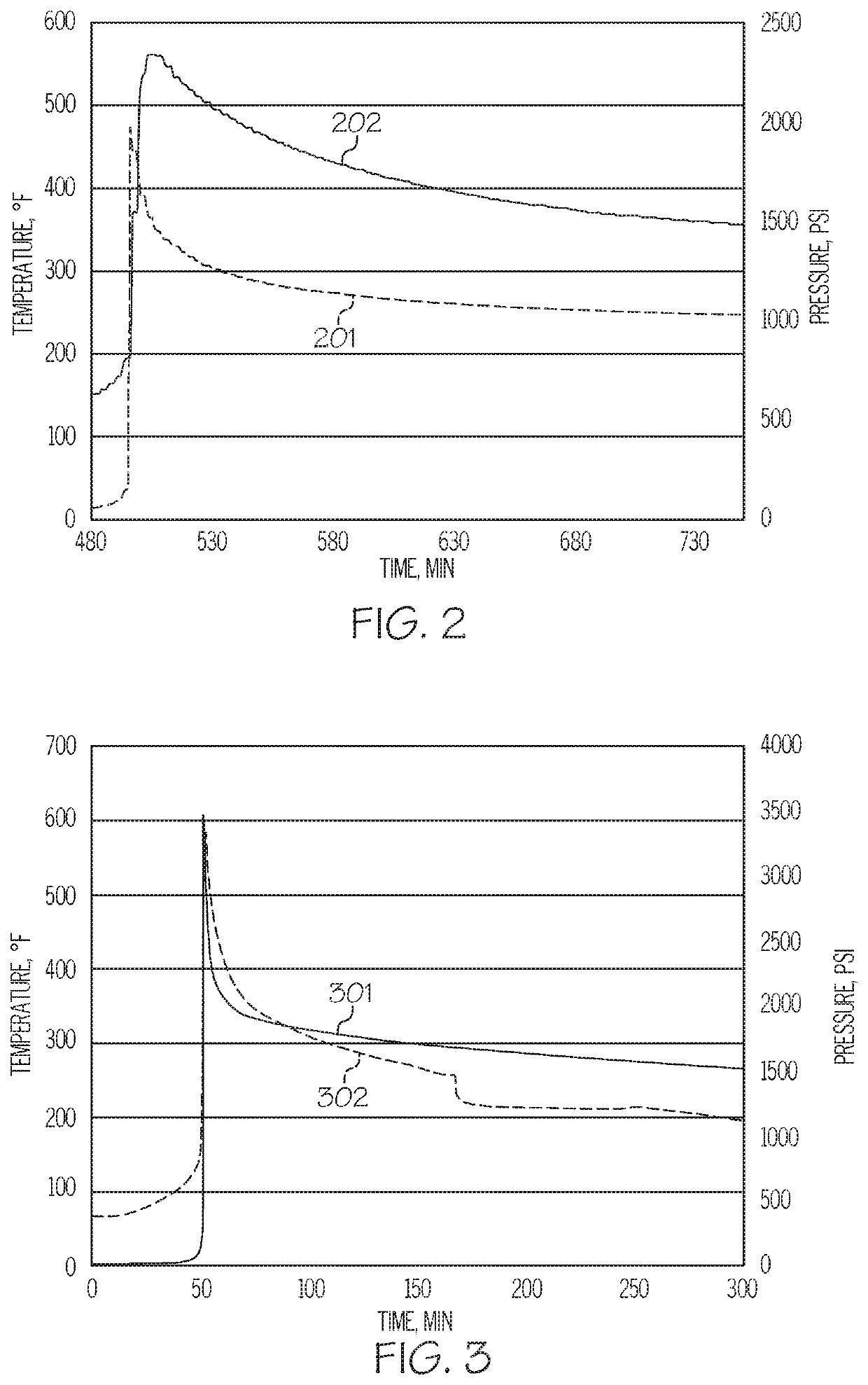Methods for recovering petroleum that include using exothermic reactions in aqueous zones of reservoirs
a technology of exothermic reactions and reservoirs, applied in the field of natural resource extraction, can solve the problems of declining productivity and increasing the number of dead wells, and achieve the effects of reducing or eliminating the negative effects of tar zones, increasing temperature and pressure, and reducing the problems associated with them
- Summary
- Abstract
- Description
- Claims
- Application Information
AI Technical Summary
Benefits of technology
Problems solved by technology
Method used
Image
Examples
example 1
[0039]Exothermic reaction components were mixed and reacted in the presence of an asphaltene sample. Example 1 utilized a reaction mixture of 45 volumetric percent (vol. %) ammonium chloride, 45 vol. % sodium nitrite, and 10 vol. % acetic acid. This reaction mixture was mixed in a 1:1 volumetric ratio with asphaltene. This mixture was placed in a viscometer (made by Anton Paar) and stirring was applied. Viscosity was continuously measured while stirring and reaction activated. As the reaction activated, temperature started to increase and viscosity started to be reduced.
[0040]FIG. 1 depicts the viscosity and the temperature of the asphaltene sample during the reaction of the exothermic reaction components. Prior to mixing, the temperature of the asphaltene sample was approximately 60 degrees Fahrenheit (° F.) and the viscosity of the asphaltene sample was approximately 6,000 centipoise (cP). Upon the mixing of the exothermic reaction components, the sodium nitrite and the ammonium c...
example 2
[0041]The effect of the exothermic reaction component volume on the exothermic reaction was measured. This example utilized a mixture of 50 vol. % sodium nitrate (3 molar concentration) and 50 vol. % ammonium chloride (3 molar concentration). The mixture was prepared and placed in a 3 liter autoclave reactor, commercially available as C-276 from Autoclave Engineers. The pressure was set to approximately 0 pounds per square inch (psi) and the temperature was increased by heating to approximately 120° F. until the reaction was triggered. The temperature and pressure change within the reactor was then measured approximately every 2 seconds for the duration of the reaction. This procedure was repeated twice: once with a 1 liter volume of exothermic reaction components and once with a 2 liter volume of exothermic reaction components.
[0042]FIG. 2 depicts the change in temperature and the change in pressure within the reactor during the reaction 1 liter of volume of the exothermic reaction...
example 3
[0043]The effect on the initial pressure of the reaction environment on the exothermic reaction of the exothermic reaction components was measured. The procedure as described in Example 2 was repeated twice, once with 1 liter of the exothermic reaction components at an initial pressure of 1,000 psi and once with 1 liter of the exothermic reaction components at an initial pressure of 1,855 psi.
[0044]FIG. 4 depicts the change in temperature and the change in pressure within the reactor during the reaction with an initial pressure of 1,000 psi. Line 401 represents the change in pressure. Line 402 represents the change in temperature. As shown by line 401, the pressure within the reactor increased from approximately 1,000 psi to a maximum of approximately 3,500 psi during the reaction, an increase in pressure of 2,500 psi. As shown by line 402, the temperature within the reactor increased from approximately 75° F. to a maximum of approximately 550° F. during the reaction. FIG. 5 depicts...
PUM
 Login to View More
Login to View More Abstract
Description
Claims
Application Information
 Login to View More
Login to View More - R&D
- Intellectual Property
- Life Sciences
- Materials
- Tech Scout
- Unparalleled Data Quality
- Higher Quality Content
- 60% Fewer Hallucinations
Browse by: Latest US Patents, China's latest patents, Technical Efficacy Thesaurus, Application Domain, Technology Topic, Popular Technical Reports.
© 2025 PatSnap. All rights reserved.Legal|Privacy policy|Modern Slavery Act Transparency Statement|Sitemap|About US| Contact US: help@patsnap.com



